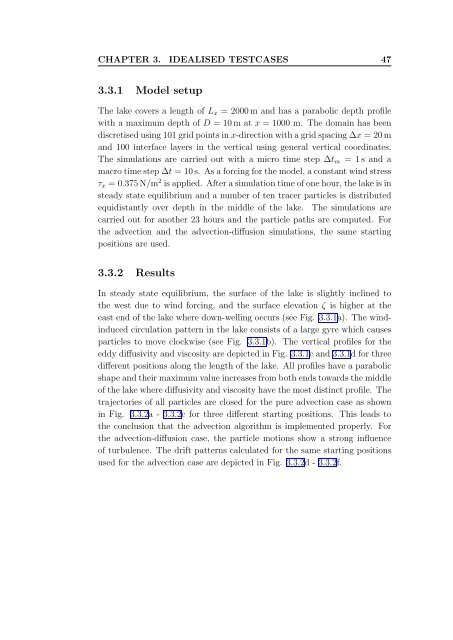Three-dimensional Lagrangian Tracer Modelling in Wadden Sea ...
Three-dimensional Lagrangian Tracer Modelling in Wadden Sea ...
Three-dimensional Lagrangian Tracer Modelling in Wadden Sea ...
Create successful ePaper yourself
Turn your PDF publications into a flip-book with our unique Google optimized e-Paper software.
CHAPTER 3. IDEALISED TESTCASES 47<br />
3.3.1 Model setup<br />
The lake covers a length of Lx = 2000 m and has a parabolic depth profile<br />
with a maximum depth of D = 10 m at x = 1000 m. The doma<strong>in</strong> has been<br />
discretised us<strong>in</strong>g 101 grid po<strong>in</strong>ts <strong>in</strong> x-direction with a grid spac<strong>in</strong>g ∆x = 20 m<br />
and 100 <strong>in</strong>terface layers <strong>in</strong> the vertical us<strong>in</strong>g general vertical coord<strong>in</strong>ates.<br />
The simulations are carried out with a micro time step ∆tm = 1 s and a<br />
macro time step ∆t = 10 s. As a forc<strong>in</strong>g for the model, a constant w<strong>in</strong>d stress<br />
τx = 0.375 N/m 2 is applied. After a simulation time of one hour, the lake is <strong>in</strong><br />
steady state equilibrium and a number of ten tracer particles is distributed<br />
equidistantly over depth <strong>in</strong> the middle of the lake. The simulations are<br />
carried out for another 23 hours and the particle paths are computed. For<br />
the advection and the advection-diffusion simulations, the same start<strong>in</strong>g<br />
positions are used.<br />
3.3.2 Results<br />
In steady state equilibrium, the surface of the lake is slightly <strong>in</strong>cl<strong>in</strong>ed to<br />
the west due to w<strong>in</strong>d forc<strong>in</strong>g, and the surface elevation ζ is higher at the<br />
east end of the lake where down-well<strong>in</strong>g occurs (see Fig. 3.3.1a). The w<strong>in</strong>d<strong>in</strong>duced<br />
circulation pattern <strong>in</strong> the lake consists of a large gyre which causes<br />
particles to move clockwise (see Fig. 3.3.1b). The vertical profiles for the<br />
eddy diffusivity and viscosity are depicted <strong>in</strong> Fig. 3.3.1c and 3.3.1d for three<br />
different positions along the length of the lake. All profiles have a parabolic<br />
shape and their maximum value <strong>in</strong>creases from both ends towards the middle<br />
of the lake where diffusivity and viscosity have the most dist<strong>in</strong>ct profile. The<br />
trajectories of all particles are closed for the pure advection case as shown<br />
<strong>in</strong> Fig. 3.3.2a - 3.3.2c for three different start<strong>in</strong>g positions. This leads to<br />
the conclusion that the advection algorithm is implemented properly. For<br />
the advection-diffusion case, the particle motions show a strong <strong>in</strong>fluence<br />
of turbulence. The drift patterns calculated for the same start<strong>in</strong>g positions<br />
used for the advection case are depicted <strong>in</strong> Fig. 3.3.2d - 3.3.2f.

















